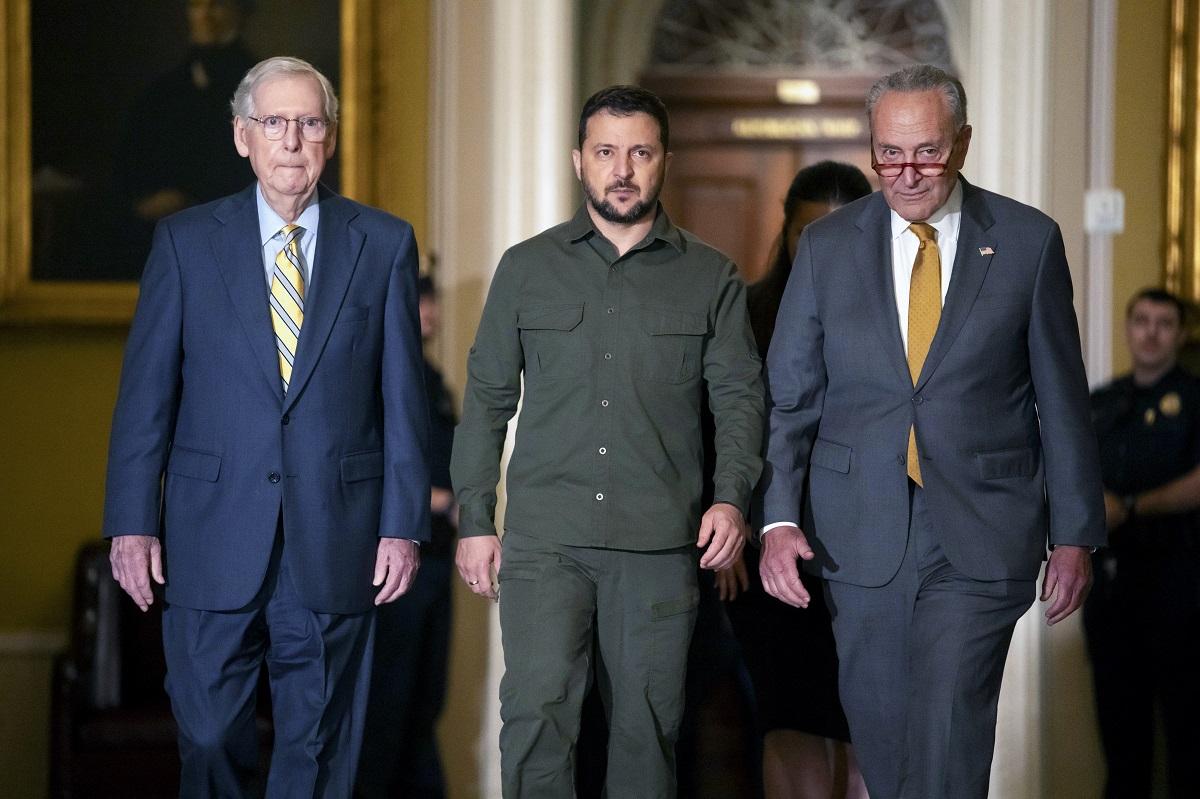Congress Didn’t Include Funds for Ukraine in Its Spending Bill. How Will That Affect the War?

Ukrainian President Volodymyr Zelenskyy, center, walks with Senate Minority Leader Mitch McConnell of Ky., left, and Senate Majority Leader Chuck Schumer of N.Y., right, at Capitol Hill on Thursday, Sept. 21, 2023, in Washington.
12:25 JST, October 3, 2023
WASHINGTON (AP) — Ukraine had little reason to celebrate when U.S. lawmakers approved a spending bill Saturday that averted a widely expected government shutdown. The measure didn’t include the $6 billion in military assistance that Ukraine said it urgently needed.
Now the Pentagon, White House and European allies are urging Congress to quickly reconsider. They warn that if the U.S. stops sending ammunition, spare parts and air defenses Ukraine will be at risk of losing ground in its counteroffensive to push back Russian forces. They argue that if Russia’s invasion is not stopped in Ukraine, other nations — including NATO allies — could be endangered.
The gridlock comes as top Pentagon leaders prepare to meet next week with allies in Brussels where Ukraine is likely to be a hot topic.
A look at what’s been provided to date and what’s at stake.
AID TO DATE
Since Russia launched its full-scale invasion of Ukraine in February 2022 the U.S. has provided $43.9 billion in weapons, including high-profile systems such as a Patriot air defense battery and Abrams tanks, almost 200 Howitzer 155mm firing systems and more than 2 million 155mm rounds, and approximately 300 million rounds of small arms ammunition and grenades.
But Ukraine needs more. The intensity of the ground conflict has meant that even with those eye-popping numbers, and additional support from European allies, Ukraine needs regular infusions of aid to sustain its forces as the war grinds on for months and possibly years.
Ukrainian President Volodymyr Zelenskyy visited the U.S. last month to lobby Congress for more assistance.
PUSHBACK
The lack of progress by Ukraine to push Russian forces back has created an opening for some members in Congress to question why the U.S. should keep sending money. A hard-right flank of Republicans, led by former President Donald Trump, the Republican front-runner in the 2024 race for the White House, is increasingly opposed to sending more money overseas. That faction was pivotal in getting Ukraine funding stripped from the last-minute 45-day funding bill that prevented a shutdown. Likewise, some European allies, including Poland, have begun to pull back on their support for the war, citing the need to prioritize their own defenses.
On Sunday after the temporary spending bill was passed, President Joe Biden warned that the cuts could hit Ukraine at a critical time. “We cannot under any circumstances allow America’s support for Ukraine to be interrupted,” Biden said, urging Congress to negotiate an aid package as soon as possible.
WHAT’S AT STAKE
The U.S. still has about $5.4 billion available that it can use to pull existing weapons from its stockpile to send to Ukraine, which should be enough in the short term based on the current usage rate, said John Hardie, deputy director of the Russia program at the Foundation for Defense of Democracies,
However, if the aid doesn’t keep flowing, Ukrainian resistance will begin to weaken soon, said Mark Cancian, a senior adviser at the Center for Strategic and International Studies. “If there’s no new money, they’re going to start feeling it by Thanksgiving,” Cancian said. The holiday falls on Nov. 23 this year.
The lack of funding now also affects next spring’s fighting, and could have a compounding effect, Hardie said. The planning for a spring counteroffensive should be starting now, “and with each passing week that just gets worse,” he said.
On Monday, the Pentagon’s top financial officer warned Congress that cutting Ukraine funding hurts the U.S. military, too — because the military’s funding to replenish the weapons systems it has sent forward is also running out.
If the pushback on U.S. funds for Ukraine “is an indicator of things to come I would say Ukraine is in trouble and so is the United States,” said John Herbst, a former U.S. ambassador to Ukraine and senior director at the Atlantic Council.
He said Russia has everything to gain if U.S. support wanes and it could cost the U.S. far more in the long run if Russia does take control of Ukraine, which would force the U.S. to further increase its military presence among NATO countries bordering Russia.
Herbst said he thinks this pushback on Ukraine funding may just be a “one-off.” Given the support for Ukraine among many Republican lawmakers, the holdout by that small faction of hard-right Republicans “antagonized a lot of people, including many in their own party. So this may be a pyrrhic victory for them” and a future bill would see the funds restored. Party leaders on both sides emphasized the need to continue supporting Ukraine in the hours after the bill passed.
INTERNATIONAL SUPPORT
One major question is if the U.S. slows or ends its support for Ukraine, will other allies follow its example?
The U.S. dwarfs all other individual donors, but other nations have also sent large chunks of money and weapons. The 27-country European Union is poised to send about $42.2 billion in aid, including more than $17.8 billion from Germany alone and $5.9 billion through EU institutions, according to the Kiel Institute for the World Economy’s Ukraine Support Tracker.
Other top contributors include Denmark, $3.7 billion, Poland, $3.1 billion, and the Netherlands, $2.6 billion.
Some of the EU’s biggest military powers are contributing only small portions: France — the bloc’s No. 2 economy and considered neck-and-neck with Britain as Western Europe’s biggest military power — has pledged $555 million and Italy some $691 million, the tracker says.
Even far-smaller Lithuania has ponied up more: $744 million.
Britain, which is no longer in the EU, has pledged nearly $6.9 billion worth of military support for Ukraine. Norway, which is also outside the EU, has committed nearly $3.9 billion.
The other nations have also been steps ahead of the U.S. on certain lethal military equipment. It was pressure from NATO allies Poland and Britain that got Germany and eventually the U.S. to provide higher-tech tanks, and Denmark and the Netherlands formed a training coalition to spur the movement of F-16 fighter jets to Ukraine.
"News Services" POPULAR ARTICLE
-

American Playwright Jeremy O. Harris Arrested in Japan on Alleged Drug Smuggling
-

Japan’s Nikkei Stock Average as JGB Yields, Yen Rise on Rate-Hike Bets
-

Japan’s Nikkei Stock Average Licks Wounds after Selloff Sparked by BOJ Hike Bets (UPDATE 1)
-

Japan’s Nikkei Stock Average Buoyed by Stable Yen; SoftBank’s Slide Caps Gains (UPDATE 1)
-

Japanese Bond Yields Zoom, Stocks Slide as Rate Hike Looms
JN ACCESS RANKING
-

Keidanren Chairman Yoshinobu Tsutsui Visits Kashiwazaki-Kariwa Nuclear Power Plant; Inspects New Emergency Safety System
-

Imports of Rare Earths from China Facing Delays, May Be Caused by Deterioration of Japan-China Relations
-

Tokyo Economic Security Forum to Hold Inaugural Meeting Amid Tense Global Environment
-

University of Tokyo Professor Discusses Japanese Economic Security in Interview Ahead of Forum
-

Japan Pulls out of Vietnam Nuclear Project, Complicating Hanoi’s Power Plans


























